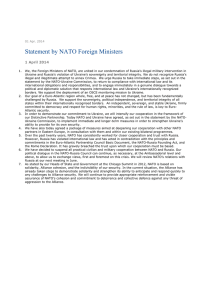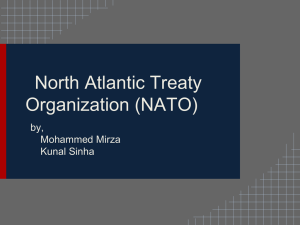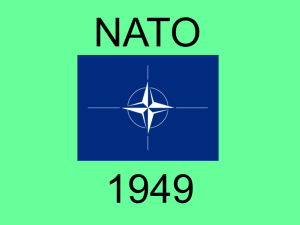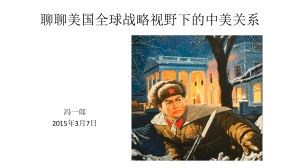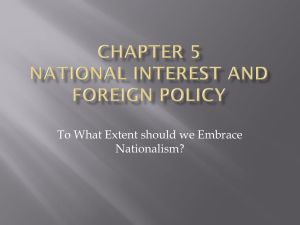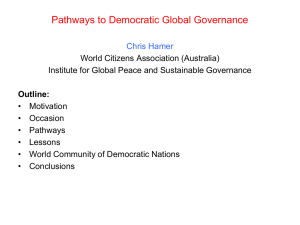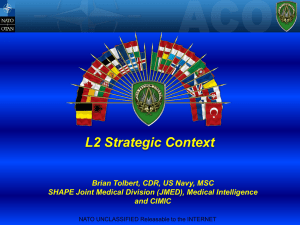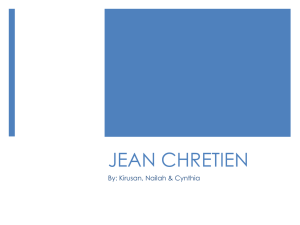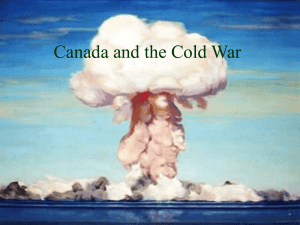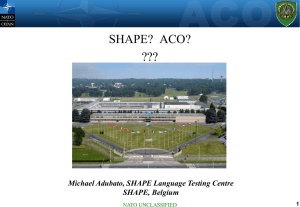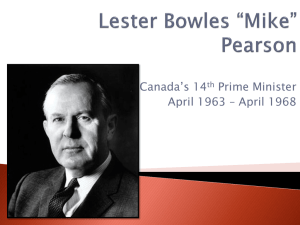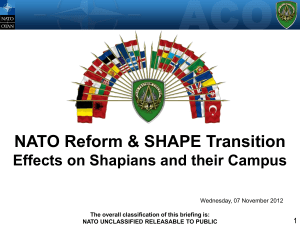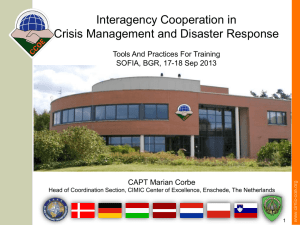here
advertisement
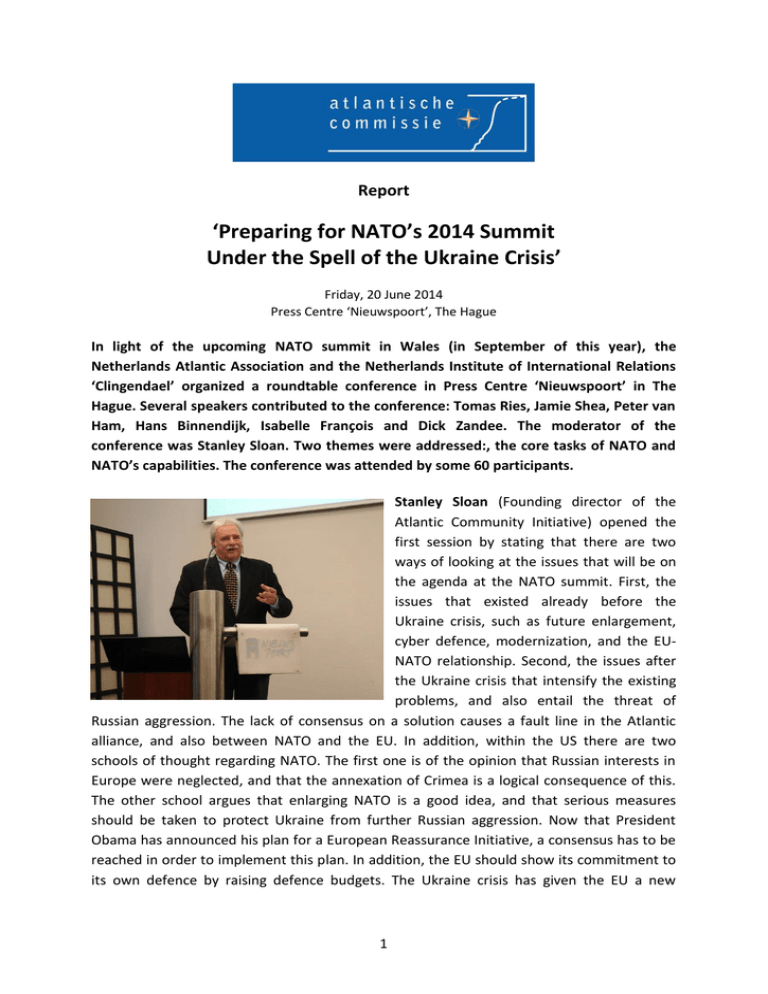
Report ‘Preparing for NATO’s 2014 Summit Under the Spell of the Ukraine Crisis’ Friday, 20 June 2014 Press Centre ‘Nieuwspoort’, The Hague In light of the upcoming NATO summit in Wales (in September of this year), the Netherlands Atlantic Association and the Netherlands Institute of International Relations ‘Clingendael’ organized a roundtable conference in Press Centre ‘Nieuwspoort’ in The Hague. Several speakers contributed to the conference: Tomas Ries, Jamie Shea, Peter van Ham, Hans Binnendijk, Isabelle François and Dick Zandee. The moderator of the conference was Stanley Sloan. Two themes were addressed:, the core tasks of NATO and NATO’s capabilities. The conference was attended by some 60 participants. Stanley Sloan (Founding director of the Atlantic Community Initiative) opened the first session by stating that there are two ways of looking at the issues that will be on the agenda at the NATO summit. First, the issues that existed already before the Ukraine crisis, such as future enlargement, cyber defence, modernization, and the EUNATO relationship. Second, the issues after the Ukraine crisis that intensify the existing problems, and also entail the threat of Russian aggression. The lack of consensus on a solution causes a fault line in the Atlantic alliance, and also between NATO and the EU. In addition, within the US there are two schools of thought regarding NATO. The first one is of the opinion that Russian interests in Europe were neglected, and that the annexation of Crimea is a logical consequence of this. The other school argues that enlarging NATO is a good idea, and that serious measures should be taken to protect Ukraine from further Russian aggression. Now that President Obama has announced his plan for a European Reassurance Initiative, a consensus has to be reached in order to implement this plan. In addition, the EU should show its commitment to its own defence by raising defence budgets. The Ukraine crisis has given the EU a new 1 opportunity to convince American EU sceptics of its commitment and willingness to follow the US. This will also send a signal to Putin that there are limits to his actions. The first speaker was Tomas Ries (Senior Lecturer at the Swedish National Defense College). Ries focused on Russia and the future of the European political order. According to him, Putin is a strong and tactical president, but he has a strategic problem: he is unable to modernize the Russian economy. A large portion of Russian money is allocated to defence, which is the opposite of what is happening in the EU. In addition, rather than NATO, the EU poses a problem for Putin. The EU stands for human rights, democracy, and modernization which undermines Putin’s vision for Russia. On the other hand, the EU has been naïve about Putin. Politicians in Western European states believed that there would never be another interstate war in Europe. They are unable to think in terms of power politics and are therefore unable to understand how Putin sees the world. Furthermore, the EU has been arrogant, ignorant and distracted by terrorism and the economic crisis. The crisis of Ukraine, however, has not been about Crimea. According to Ries, it is a clash between civilizations with fundamentally different worldviews. It also marks the end of liberal Western rule, and therefore changes the future of the European political order. Jamie Shea (Deputy Assistant Secretary General for Emerging Security Challenges at NATO). focused on the changing position of NATO. Shea argued that everything NATO does will be tested, and that the alliance is no longer able to make ‘empty promises’. In addition, the period of choosing our battles and easy enemies is over. There are multiple crises going on at the same time, and NATO should be able to act in all of these. However, right now the key issue for NATO is the crisis in Ukraine and the relation with Russia. According to Shea, it is of importance to research and understand Russia’s behaviour. In addition, the military should be better prepared and should be able to respond quickly. There should be a permanent military presence, to help with the reassurance of Eastern Europe. Some say there should be a rotation of forces in and out of Eastern Europe, which has the advantage of scalability. NATO should also consider its way of deterrence, and discuss if conventional military deterrence is enough. NATO also needs to be aware of other possible conflicts, and it is in its interest that 2 states as Moldova are in the sphere of influence of the EU. An effective way forwards for the alliance has to be found during the NATO summit. Peter Van Ham (Senior Research Fellow at the Clingendael Institute) argued that the Ukraine crisis will not escalate. The crisis offered the US the opportunity to further its political agenda. The US would like to see defence budgets of the EU allies raised, and because of the Ukraine crisis the possibility for raising these budgets is up for debate in these countries. It is also the ultimate chance to shift the focus towards NATO. According to Van Ham, the Ukraine crisis is not a gamechanger. Since 2008 Russia has asked to be more involved in EU security, but the EU allies have largely ignored this. NATO should therefore change its attitude towards Russia, in order to not provoke Russia any further. In addition, Ukraine cannot become a member of NATO or the EU, because Russian support is needed for both the EU and NATO. For example: Russia’s cooperation in the UN Security Council is needed. NATO should also be aware of Russia’s drift towards Asia in both economic and strategic aspect. In conclusion, NATO should see Russia as an ally and not as an enemy. NATO should therefore think about its relationship with Russia, because antagonizing Russia could come at a high prize. According to Isabelle François (Senior Fellow at the Atlantic Council's Brent Scowcroft Center on International Security), the Ukraine crisis is strengthening the solidarity within NATO. The alliance needs to stay firm and united. The response to the Ukraine crisis was well-organized, with immediate air policing and increased naval presence in the region. However, the alliance should look at the long term of which a renewed sense of commitment is most important. There should be a focus on capabilities and strong collective defence. At the moment, there is a lack of funding, but the economic recovery provides the opportunity to set new goals for increasing defence spending. Increased spending of the EU members is necessary for US commitment to NATO. NATO should also determine a vision for its relation with Russia and the cooperation with Eastern European states. The partnership with Russia never materialized, and the negative relation between Russia and NATO makes it difficult for Eastern states to become NATO members. Because of this difficult relationship, NATO also has to come up with a strategy concerning Moldova, Georgia and Ukraine. Together with the 3 EU, NATO has to review the European security architecture. According to François, NATO is flexible but is nevertheless facing a challenging situation. After François’ presentation, the floor was open for discussion. Topics that were discussed included the EU-NATO relationship, and the reputation of NATO. The second session discussed NATO’s capabilities. Hans Binnendijk (Senior Fellow at the SAIS Center for Transatlantic Relations of the Johns Hopkins University) joined the discussion via Skype. Binnendijk offered his view on the defence budgets and the military capabilities of NATO, which will be discussed at the upcoming NATO summit. Currently, the US carries the heaviest burden of NATO defence spending. Binnendijk suggested that there should be a pledge of the allies to a defence budget of 2% GDP because now many countries spend less than is agreed. The effects of the declining budgets are already visible, according to Binnendijk. Within the EU, the defence ministers are beginning to understand that the budgets have to be raised. Several parts of the military are well-developed, such as command and control, and special operation forces. However, the EU should have full spectrum defence capabilities as its goal. One of the options to accomplish this, is the framework nation approach. The gaps in defence capabilities of stronger states can be filled through cooperation with smaller states. For example, Germany could be supported by two smaller states to create full spectrum defence capabilities. Concerning East-European defence, Binnendijk remarked that the European Reassurance Initiative can only be successful if it is widened by European initiatives and deepened by longer US commitment. The last speaker of the conference was Dick Zandee (Senior Research Fellow at the Clingendael Institute). He presented an overall strategic picture of NATO capabilities. He argued that an extremely broad package of capabilities is needed, which maintenance is determined by four factors. The first one is defence spending. With the recent Ukraine crisis, raising the defence budgets is open for discussion. Second, the division in Europe over NATO’s security priorities should be solved. Third, the individual security priorities are also divergent. Fourth, modern military technology is increasingly expensive. Zandee then 4 offered four scenario’s for NATO’s future. First, all in – all out: all allies are committed to Article 5, which needs maximum solidarity and burden sharing, or all allies focus on out of area missions. This option is difficult to maintain. Second, nobody in – all out: no emphasis on Article 5, which creates the possibility for NATO to solely focus on out of area missions. Third, all in – nobody out: complete focus on Article 5, especially the protection of member states in Europe. Fourth, some in – some out: some member states focus on Article 5, but there is also room for other member states to focus on crisis management. Zandee said that it is likely that NATO combines aspects of these scenario’s as they are extreme examples. However, during the summit NATO should focus on a strategy for its future use of capabilities. Finally, there was the opportunity for the audience to ask questions to all of the speakers. Topics that were discussed were the export of weapons of NATO members to its adversaries, and the crisis concerning ISIS in Iraq. Femke de Haan and Sanne Wirken 5
